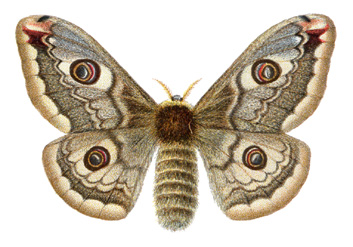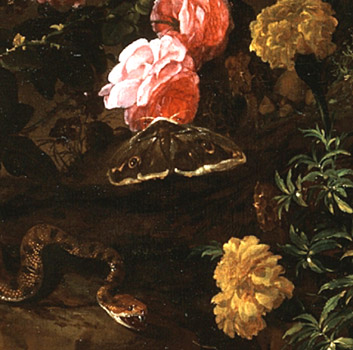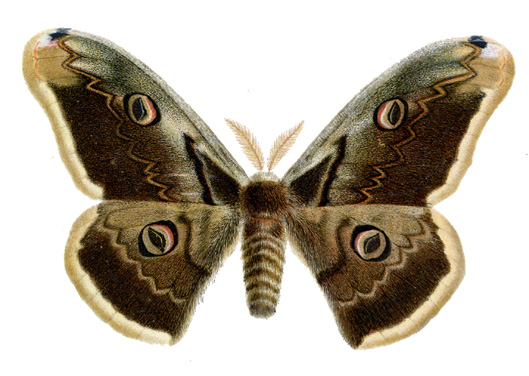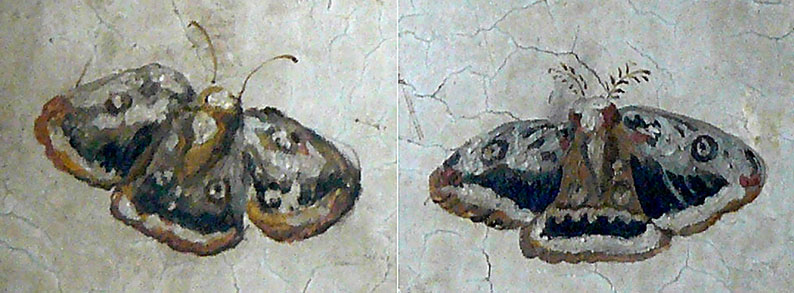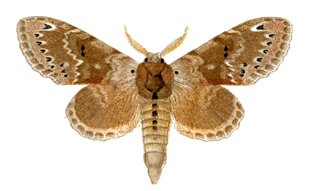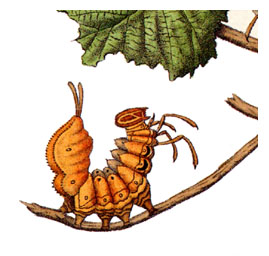Butterflies and Moths in Nabokov's Published Writings
Alphabetical Order ‒ Page 10
Queen of Spain: »Issoria lathonia
Rebel's Blue: »Maculinea rebeli
Red Admirable, Red Admiral: »Vanessa atalanta
Reverdinus Ragusa, 1919: an abandoned genus of »Hesperiidae (skippers), subfamily Pyrginae (pyrgine skippers). The type-species was »Carcharodus flocciferus Zeller, 1847, the Tufted Skipper, in SE Europe, Bulgaria, Asia Minor, S Siberia.
*NabBut 577 (BE)
Rhopalocera (singular Rhopaloceron): any butterfly, as contrasted to a »moth (Heteroceron). Rhopalocera, or butterflies, are one of the two basic groups of Lepidoptera. See in »Introduction.
*N/WLet 142=113old; SelLet 413
& Ac: Rhopalócera • En: butterflies • Fr: papillons diurnes • Ge: Schmetterlinge, Tagfalter, Diurna • It: farfalle • Ru: бабочки • Sp: mariposas
Rhoptria (ex Gnophos) asperaria Hübner, 1817 [Geometridae, Ennominae]: a geometer moth in S Europe.
*Lep2 257
Riodininae Grote, 1895 (ex Erycinidae, Nemeobiidae): a subfamily of Lycaenidae with wingspans of 16–50 mm, often with raised and shiny metallic markings and a chequered pattern, counting some 1,500 species, most of them in tropical America. "A resplendent and bizarre family, especially rich in American genera and species. Poorly represented in the Palearctic…" ("Butterflies of Europe", 1964). "It [»Emesis zela] belongs to a tremendous family of South American butterflies, and they mimic all kinds of butterflies belonging to other families. Keeping up with the Smiths, you know". For instance, Ancyluris inca Saunders, 1850 recalls a Callicore, Helicopis endymion Cramer, 1779 a hairstreak, Stalachtis calliope Linnaeus, 1758 an ithomiine and the only European genus with just one species (»Hamearis lucina) a fritillary (a group of nymphalids). In the earlier higher classification, the Riodininae used to be considered a family of their own (Riodinidae).
*NabBut 575 (BE), 604 (BE); Lep9 2; Int1 128
& Ac: Riodinínae • Am: metalmarks • En: dukes • Fr: érycinidés, riodinines • Ge: Scheckenfalter, Würfelfalter • It: riodinidi • Sp: riodínidos
ringlet: While the Ringlet of Britain (capital R) is the Palearctic butterfly »Aphantopus hyperantus Linnaeus, 1758 [Nymphalidae, Satyrinae], in America it is the Holarctic Coenonympha tullia Müller, 1764.
A number of other satyrine species are also called ringlets, with some epithet or other. For instance, Coenonympha tullia inornata W.H. Edwards, 1861 is the Inornate Ringlet. Their distinguishing mark is a small ringed eyespot, or a sequence of them, on the tips of the forewings and along the edge of both wings. When they are resting and have their wings folded up, many of them show an eyespot near the tip of the wings' undersides. In America, they are to be found in the genus »Coenonympha Hübner, 1819 (whose European members in Britain are called heaths and not ringlets). The ringlets of Europe (other than The Ringlet) are the members of the genus »Erebia Dalman, 1816, with »Erebia ligea Linnaeus, 1758 as its type-species. The common name does not denote a scientific taxon. So if there are no additional cues, 'ringlet' is almost impossible to translate except in a descriptive way, as a satyrine with small ringed eyespots.
The ringlets of Strong Opinions (p. 200) are to be found on the flowery slopes of the European Alps. They could be either Ringlets pure and simple (that is, »Aphantopus hyperantus), Coenonympha species or Erebias. In all likelihood, it is Erebias that Nabokov had in mind. They are highly typical of sunny meadows in the Alps, usually showing up in multitudes, sauntering leisurely and low and going into hiding as soon as the sun disappears even for a moment. There is a bewildering number of varieties – about eighty species, from yellow to orange to fuscous to downright black, varying with geographical direction and altitude. So if there is a name for dark alpine satyrines of the genus Erebia (like the French term 'moiré' or the German 'Mohrenfalter'), the translator would be justified to use that.
The "black Ringlet butterflies in our park" of The Gift (p. 109) probably are Erebias, too. In French, Nabokov had them rendered 'nègre'. Two species who are especially dark are the Sooty Ringlet (»Erebia pluto de Prunner, 1798) in the Alps and the Black Ringlet (Erebia melas Herbst, 1796) in the mountains of SE Europe, from Slovenia to Greece. In both, the males are a unicolorous velvety black.
*Gift 109, 133; SpeakM 132; StrOps 200, 334; SelLet 473
& Ac: Coenonýmpha túllia • Am: (Tullia) Ringlet • En: Large Heath • Fr: le fadet des tourbières • Ge: Großer Heufalter • Ru: синница болотная • Sp: ninfa de Müller
& Ac: Aphántopus hyperántus • En: Ringlet • Fr: le tristan • Ge: Brauner Waldvogel • Ru: бархатница Гиперант • Sp: sortijitas
& Ac: Erébia ligéa • En: Arran Brown • Fr: le moiré blanc fascié • Ge: Milchfleck • Ru: чернушка Лигия • Sp: erebia ligea
Roborovski's White: »Pieris deota
Romanoff's olga: »Colias caucasica
sareptensis: »Plebejus melissa
Saturnia Schrank, 1802: a genus of »Saturniidae, subfamily Saturniinae. The type-species is »Saturnia pyri, the (European) Emperor Moth or Pear Peacock.
|
Saturnia pavonia (Lampert 1907) |
An Emperor Moth (Saturnia pavonia or spini) in a painting by Paolo Porpora (1617-1673): "Provence Roses, Shells, Turtle and Butterfly in a Landscape". See also »Butterflies in Art. |
|
|
|
Saturnia (ex Eudia) pavonia Linnaeus, 1758 [Saturniidae]: a large, though not the largest European emperor moth with a wingspan of 40–68 mm in the males and 48–90 mm in the females, with a plump body. It is a smaller version of »Saturnia pyri, without the chocolate brown of that species. The basic color of the female is gray, while the hindwings of the male are of an orange brown. As with all saturniids, there is a striking dark eyespot on each wing. Its range is all over Europe and Asia, including the Amur and Ussuri basins.
Robert Michael Pyle writes that the somnolent "semi-pavonian creature" of Nabokov's poem "In Paradise", written 1927 ("… a wild angel… Poke at it curiously / with your green umbrella") suggests Saturnia pavonia. The name most certainly does; but then paradise must have added a blue to its appearance that the original lacks.
Cf. also »Automeris io.
*SpeakM 121; NabBut possibly 107 (P), 123
& Ac: Satúrnia/Éudia pavónia • En: Emperor Moth • Fr: le petit paon de nuit, (Autres rivages) le Paon-de-nuit • Ge: Kleines Nachtpfauenauge • It: saturnia pavone / minore • Ru: павлиноглазка обыкновенная, мапая сатурния • Sp: pequeño pavón nocturno / de noche
|
Saturnia pyri (Lampert 1907) |
|
|
|
The two "Pear Peacock" Moths (f left, m right) in the Elements Room of the Palacio Vecchio in Florence (© DEZ 2009) |
|
|
Saturnia pyri Denis & Schiffermüller, 1775 [Saturniidae]: the Peacock Moth, an emperor moth and the largest Lepidopteron in the warmer parts of Europe, W Asia and N Africa, with a wingspan of 100–130 mm. The wings have a wavy brownish, blackish and ocher pattern, usually with much chocolate brown, and a pale outer marginal band. There is a brown, red and black ringed eyespot on each wing. It flies only by night, circling around street lanterns and resembling a bird or a bat. It does not eat, living only as long as the fat reserves last. The Peacock Moth flies from late April to early June. There is just one brood. The large green caterpillar with blue knobs (length 80 mm, diameter 20 mm) lives in orchards and feeds on the leaves of apple and pear trees. The pupa overwinters. (Latin pirum or pyrum is 'pear' and 'apple,' whence the name Pear Peacock in Ada.)
This is the moth that in Invitation to a Beheading so scares Cincinnatus' jailer Rodion: "It was as large as a man's hand; it had thick, dark-brown wings with a hoary lining and gray-dusted margins; each wing was adorned in the center with an eyespot, shining like steel. Its segmented limbs, in fluffy muffs, now unstuck themselves, and the upraised vanes of its wings, through whose underside the same staring spots and wavy gray pattern showed, oscillated slowly … its brown, white-dappled abdomen, its squirrel face, the black globules of its eyes and its feathery antennae resembling pointed ears." Gennady Barabtarlo identified this insect as "a female of the Emperor Moth, »Saturnia pavonia Linnaeus, the largest European moth" (Slavic Review, 49 [3], Fall 1990, p. 390–397). Though the description does in some ways fit pavonia as well as pyri, pavonia is by no means the largest European moth. Saturnia pavonia's wingspan is just about half of that of pyri, and thus it is not nearly "as large as a man's hand". Also the overall color is not dark-brown but gray and brown. In a letter to Alfred Appel, Jr., Nabokov confirmed that is was Saturnia pyri.
Karges (1985) tentatively identifies the Peacock Moth in "Lines Written in Oregon" as »Antheraea polyphemus Cramer, 1776 [Saturniidae], and that it could be, being the commonest of all N American Saturniids, present in ten counties of Oregon. Saturnia pyri is strictly Palearctic and does not fly in America.
In Ada (II,7), there is a paragraph on a Renaissance painting of the Peacock Moth. Ada and Van, reunited for a while, are looking at a photo album they have from an alleged blackmailer. The snapshots were taken about eight years before in Ardis manor and park; some show young Ada and Van in compromising attitudes. This is one of them: "Two huge common Peacock moths, still connected. Grooms and gardeners brought Ada that species every blessed year; which, in a way, reminds us of you, sweet Marco d'Andrea, or you, red-haired Domenico Benci, or you, dark and broody Giovanni del Brina (who thought they were bats) or the one I dare not mention (because it is Lucette's scholarly contribution – so easily botched after the scholar's death) who likewise might have picked up, at the foot of an orchard wall, not overhung with not-yet-imported wisteria (her half-sister's addition), on a May morning in 1542, near Florence, a pair of the Pear Peacock in copula, the male with the feathery antennae, the female with the plain threads, to depict them faithfully (among wretched, unvisualized insects) on one side of a fenestral niche in the so-called 'Elements Room' of the Palazzo Vecchio."
The painting is there, in the Palazzo Vecchio of Florence, on the second floor. The Elements Room (Quartiere degli Elementi) is one of several rooms of the "new quarters" in the back of the Palace. It has its name from the allegorical paintings of the four elements that adorn three of its walls and its ceiling. There are three windows, all opening on the Via di Ninna. On the right hand side of the middle window niche there are two Peacock Moths, both about natural size, that is about 110 mm wide. They are about 30 cm apart and not in copula. But if the painter noticed that there is a difference between males and females and that it shows in the look of their antennae, somebody must have caught a pair in copula for him. The one on the right has featherlike (or plumose] antennae (the male), the left one has straight shafts (the female). In the same window niche there are eight other butterflies and dragonflies, all nondescript. So far there is no problem to the paragraph. The painting exists where it is said to exist, and there is no question as to which moths it depicts.
The rest of the paragraph is less clear. It would be tempting to decide which was the scholarly name Lucette contributed and the author withheld. However, the three names given do not accord well enough with what is known about the genesis of the Elements Room to allow an easy solution. The Elements Room was decorated from 1555 to 1556 under the direction of the painter, architect and writer Giorgio Vasari (1511–1574). Vasari had left the Pope's service in 1554 to become court artist of Grand Duke Cosimo I di Medici. One of his first tasks was to completely refurbish the town palace in Florence. From the payrolls that still exist we know that he was aided by several assistants: the painters Cristofano di Guido Gherardi, known as 'Doceno' (born 1508 in Borgo San Sepolcro, died 1556 in Borgo San Sepolcro), Marco d'Andrea Marchetti da Faenza (1527?–1588), Bacco di Michele, Bartolomeo di Michele di Ridolfo, Domenico di Lorenzo di Benci (or Beceri) and Giovanni di Matteo del Brina (c. 1540–1599). Other assistants were the Venetian stucco worker Giovan Matteo di Niccolò, Giovanni di Zanobi who ground the colors and Mariotto di Francesco who applied the gold. They all were working simultaneously on several rooms of the new quarters, starting with the Elements Room.
Gherardi and Marco da Faenza were mainly responsible for the fanciful earthy detail (called grotesque) behind and between Vasari's academic allegories. The finestral niches including the Peacock Moths were painted by "sweet" Marco da Faenza. Vasari called him "particularly skilled in fresco work, proud, resolute and awesome, most of all in the manner of painting grotesques in which he … has no equal nor anyone to add to his perfection". There is a portrait of him one floor below, on the ceiling of the large "Hall of the 500" he also helped to decorate.
So all three artists mentioned in Ada were united in the work on the Elements Room, but "red-haired" Domenico di Lorenzo di Benci and "dark and broody" Giovanni del Brina had only very minor parts and were not involved with the window niches. The latter was still a boy.
Vasari's most important assistant by far, however, was Gherardi. In fact, he was more than an assistant. He is independently credited with some of the room's finest paintings, and he was a close friend who had collaborated with Vasari before, in Florence, Bologna, Venice (where they had designed the decorations for Pietro Aretino's play Talanta), Rome and Rimini. Gherardi had been banned from Florence by Cosimo's predecessor for a slight political offense, and one of the first things Vasari did when he moved from Rome to Florence was to arrange his pardon so he could return and work with him. Vasari was deeply grieved by Gherardi's sudden death on April 4, 1556, in the middle of the work on the Elements Room. He wrote to the Duke: "His death has been a great loss to me in the work on the palace, for his help was invaluable and his virtuous soul gave me comfort in moments of adversity, advice and help in times of difficulty during our twenty-four years of life and work together … I wept for him and still weep when I realize that I cannot carry on with my work with the same drive as before, feeling that half of me is missing; I will never find another who for his efforts and his rare kindness can replace Cristofano." Vasari also sang Gherardi's praises in an essay of some thirty pages in volume 6 of his Vite.
So what to make of the list Marco d'Andrea, Domenico Benci, Giovanni del Brina and X? There is one name conspicuously missing, that of Cristofano Gherardi. The omission is all the more surprising for two reasons. Gherardi's name is mentioned in all the literature on the Palazzo Vecchio, even in travel guides, so Nabokov cannot have failed to come across it. And everybody who doesn't know that Marco da Faenza painted the Peacock Moths (as perhaps Nabokov did not) must have assumed they were by that master of the grotesque, Gherardi.
My unproven hypothesis is that Lucette had Gherardi in mind who is so ostentatiously absent from that paragraph, perhaps suspecting from the tone of Vasari's grief that both had been lovers. It may be noted that on the evening when Ada taught her half-sister Lucette what sex is about (thus adding lesbian love to incest), "tremendous moths walked on all sixes up the window panes". No European moth would deserve the word "tremendous" more than the Peacock Moth. In May, 1542, Vasari had just begun to decorate his own house in Arezzo (Casa del Vasari), 40 miles SE of Florence. It has a small garden. Peacock Moths are still flying in Tuscany. There is no way of knowing, however, what happened in May, 1542 in an orchard near Florence. There is no evidence that Gherardi joined Vasari in Arezzo to help him paint his Casa.
On the other hand, the actual painter of the two moths, Marco di Faenza, was about the same age (fourteen) in 1542 as Van was when he fell in love with Ada in the arbors of Ardis.
Most of the information in this article comes from The Apartments of Cosimo in Palazzo Vecchio by Ugo Muccini and Alessandro Cecchi (Firenze: Le Lettere, 1991); on p. 48 Marco da Faenza is identified as the painter who had done the finestral niches.
In a letter to Alfred Appel, Jr. (July 27, 1967), written from Limone Piemonte where he was looking for »Boloria graeca tendensis, Nabokov made this remark: "Moths … are as graceful and often as gaudy as true butterflies. In Invitation to a Beheading I have a saturnid moth which represents grace and beauty and art at their highest." He was speaking of Saturnia pyri.
In Ada (p.250), there are several moths not mentioned by name, one of them being "thick-set rake-hells with bushy antennae". Bushy (or "plumose", feathery) antennae are found in many male moths (only the males) of Saturniidae, Lasiocampidae and others. The "rake-hells" mentioned could be any of them. Saturnia pyri here is chosen as an example because the pictures clearly show the bushy antenna of the male and because Nabokov himself pointed out its "feathery antennae" in the Palazzio Vecchio depiction.
See also »Butterflies in Art.
*Perhaps Glory 158; InvBeh 203–204; Ada 400, possibly also 250; Lines/Poems 33, P&P 171; NabBut 640, 649
& Ac: Satúrnia pýri • En: (Great) Peacock Moth, Large (Viennese) Emperor, (Ada) Pear Peacock • Fr: le grand paon de nuit, (Ada) le Paon de nuit, le Paon du Poirier • Ge: Großes (Wiener) Nachtpfauenauge • It: saturnia del pero, gran pavone, pavone di notte • Ru: павлиноглазка грушевая, грушевая сатурния • Sp: gran pavón
Saturniidae Walker, 1855 (ex Attacidae): a family of night-flying moths, most of them large and very large with a stout body and strikingly beautiful wing patterns; often they have an eyespot on each one of their four wings. There are around 1,200 species, most of them in tropical SE Asia and Australia.
& Ac: Saturníidae • En: saturnids, emperor moths, giant silkmoths • Fr: saturniidés, paons de nuit • Ge: Saturniiden, Nachtpfauenaugen, Augenspinner • It: saturnidi • Ru: павлиноглазки • Sp: satúrnidos
In Nabokov's long nostalgic poem on the joys of luring moths written in 1922, the first one he takes is "a puffy silkmoth, / speckled, like a fallen leaf". Discounting the Ailanthus Silkmoth (Samia cynthia Drury, 1773) that was introduced to Europe and America only later on, there are very few Silkmoths (that is, Saturniids) in Europe. So there is little choice. It must be either one of the three European Saturnia species (»Saturnia pavonia, »Saturnia pyri or Saturnia spini Denis & Schiffermüller, 1775) or else »Aglia tau. Of these, pyri and spini occur farther to the south, leaving the Emperor Moth (Saturnia pavonia) and the Tau Emperor (Aglia tau). Both are frequent in the region of St. Petersburg. The color of the Tau Emperor is tan, making it more like a withered leaf than the Emperor Moth where only the hindwings of the males are tanned. In addition, some Tau Emperors are heavily dusted ("speckled") with dark brown or black scales. This makes the Tau Emperor a more likely candidate.
*NabBut 107 (P)
satyr: any member of the subfamily »Nymphalidae, subfamily Satyrinae. In a narrower sense, only the tribe Satyrini (US true satyrs, GB graylings). In a still narrower sense, the members of the genus Satyrus Latreille, 1810; the type-species is Satyrus actaea Esper, 1780, the Black Satyr of SW Europe.
*SpeakM 138: "gray-marbled Satyrs"
& Ac: Sátyrus actáea • En: Black Satyr • Fr: (Autres rivages) le satyre marbré de gris • Ge: *graumarmorierter Satyrfalter
satyrid: any member of the former family Satyridae (now »Nymphalidae, Satyrinae). The "European trifle" from the Crimea, "recently described by Kuznetsov" and shown to Fyodor by his father, is »Pseudochazara euxina.
*Gift 129
Satyrinae Boisduval, 1833: a cosmopolitan subfamily of »Nymphalidae that used to be (and often still is) regarded as a family in its own right (Satyridae, satyrids). They are a cosmopolitan subfamily of around 2,500 species, with some 100 in Europe and some 50 in N America, of small to medium size. They fly mainly on open or forest meadows, some at considerable altitudes but usually near the ground. The first butterfly one will encounter on a sunny Alpine meadow is likely to be some satyrine species fluttering over the grass. Most of them are some shade of brown, gray or even black, and practically all have two or more larger or smaller eyespots, to divert predators. The veins of their forewings are swollen, and their forelegs are reduced, as in all nymphalids (called brushfoots in America). It is for this characteristic that they have been downgraded to a subfamily.
*NabBut 207 (FB), 270 (L); LtVé 475
& Ac: Satyrínae • En: satyrines (US satyrs, browns, wood nymphs, ringlets, alpines, GB graylings, ringlets, heaths, browns) • Fr: satyridés (satyres, etc.) • Ge: Augenfalter • It: satiridi • Ru: бархатницы, (DarII) сатириды, (Nabokov) сатира • Sp: satíridos
Satyrium Scudder, 1876: a genus of »Lycaenidae, subfamily Theclinae (hairstreaks). The type-species of this holarctic genus is »Satyrium fuliginosum.
Satyrium (ex Thecla) abdominalis Gerhard, 1850 [Lycaenidae]: formerly considered only a local variety of the Sloe Hairstreak (»Satyrium acaciae Fabricius, 1787) the range of which is Spain, S Europe, Turkey and S Russia, this has been promoted to species rank, in Turkey and on the Black Sea.
*Lep1 30
Satyrium acaciae Fabricius, 1787 [Lycaenidae]: Sloe's Hairstreak, described from S Russia, in Spain, S Europe, Turkey and S Russia. "The only spot where I ever found it common was a Tatar village cemetery on the S. coast of the Crimea, in June, 1918."
*NabBut 610 (BE)
Satyrium (ex Callipsyche) behrii W.H. Edwards, 1870 [Lycaenidae]: Behr's Hairstreak, from S British Columbia to C California and New Mexico.
*Lep16
Satyrium calanus Hübner, 1809 [Lycaenidae]: the Banded Hairstreak, in the Rocky Mountains.
*NabBut 398 (L)
Satyrium (ex Strymon) edwardsii Grote & Robinson, 1942 [Lycaenidae]: Edward's Hairstreak, from Canada's Maritime Provinces west to Manitoba and south to Georgia and Texas.
*Lep16
Satyrium fuliginosum W.H. Edwards, 1861 [Lycaenidae]: the Sooty Gossamer Wing, from S British Columbia to C California.
*StrOps 326; Lep14 510
Satyrium (ex Thecla) ilicis Esper, 1779 [Lycaenidae]: a Palearctic hairstreak, in C and SE Europe, Turkey, Near East, W and S Urals, NW Asia. Satyrium ilicis inalpina Verity, 1911 is a valid subspecies.
*NabBut 610 (BE); Lep2 270
& Ac: Satýrium ilícis • En: Ilex Hairstreak • Fr: le thécla de l'yeuse • Ge: Brauner Eichenzipfelfalter
Satyrium pruni (Hofmann 1894)
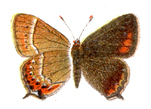
Satyrium (ex Strymonidia, Thecla) pruni Linnaeus, 1758 [Lycaenidae]: a small Palearctic hairstreak, almost black with some orange on the hindwings, wingspan of 27–30 mm, in C and E Europe, S Siberia, Mongolia, Korea, Japan.
*NabBut 220 (FB)
& Ac: Satýrium prúni • En: Black Hairstreak • Fr: le thécla du prunellier • Ge: Pflaumenzipfelfalter • Ru: хвостатка сливовая, (DarII) сливовая тэкла
Satyrium (ex Strymon) saepium Boisduval, 1852 [Lycaenidae]: the Hedge-row Hairstreak, from British Columbia and Washington to Montana.
*Lep16
Satyrium (ex Thecla) spini Denis & Schiffermüller, 1775 [Lycaenidae]: the Blue-spot Hairstreak, in S and C Europe to Turkey, Lebanon, Iraq and Iran, described from Vienna.
*Lep2 270
Satyrium sylvinus itys W.H. Edwards, 1882 [Lycaenidae]: the Itys Hairstreak, a subspecies of the Sylvan Hairstreak, in Arizona.
*Lep16
Satyrium (ex Strymonidia, Thecla) w-album Knoch, 1782 [Lycaenidae]: a hairstreak with a wingspan of 27–30 mm, in C and E Europe, Turkey, Urals, Kazakhstan, Japan, described from Leipzig.
*Lep1 30
& Ac: Satýrium/Strymonídia/Thécla w-álbum • En: White-letter Hairstreak • Fr: le w-blanc, le thécla de l'orme • Ge: Ulmenzipfelfalter • Ru: хвостатка В-белое • Sp: w-blanca
Satyrodes eurydice eurydice Johansson, 1763, syn canthus Linnaeus, 1767 [Nymphalidae, Satyrinae, Parargini]: the Eyed Brown, from Delaware to N Illinois, northward to C Quebec and northwestward to the Northwest Territories.
*NabBut 398 (L)
Satyrus Latreille, 1810: a genus of »Nymphalidae, subfamily Satyrinae, tribe Satyrini (US true satyrs, GB graylings). The type species is Satyrus actaea Esper, 1780, the Black Satyr of SW Europe.
*NabBut 575 (BE)
Satyrus anthe: »Chazara persephone
Satyrus circe: »Brintesia circe
Satyrus ferula Fabricius, 1793 [Nymphalidae, Satyrinae]: the Great Sooty Satyr, in Morocco, S Europe, Turkey, Middle East, Transcausasia, Ukraine, S Urals, Kazakhstan, SW Siberia, W China. The wingspan is c. 58 mm, the males are bitter chocolate brown with two small ringed eyespots on the forewings.
*NabBut 588 (BE)
Satyrus statilinus: »Neohipparchia statilinus
Scarce Heath: »Coenonympha hero
Scarce Swallowtail: »Iphiclides podalirius
Scelotrix Rambur, 1858: an abandoned genus of »Hesperiidae (skippers), subfamily Pyrginae (pyrgine skippers). The type-species was Scelotric fritillarius Poda, 1761, a synonym of »Pyrgus carthami.
*NabBut 577 (BE)
Scolitantides Hübner, 1819: a genus of »Lycaenidae, subfamily Polyommatinae (blues), tribe Polyommatini, Glaucopsyche Section. The type-species is »Scolitantides orion, the Chequered Blue. "Another very distinct genus. Equivalent to subfamily Glaucopsychinae of Forster (1936) and the tribe Glaucopsychidi of Hemming (1931)." In present-day classification, Scolitantides and most of the other subgenera listed by Nabokov (Glaucopsyche Scudder, 1872, Zizeeria Chapman, 1910, Maculinea van Eecke, 1915 and Iolana Bethune-Baker, 1914) are assembled in the Glaucopsyche Section, tribe Polyommatini, subfamily Polyommatinae.
*StrOps 333; NabBut 465 (L), 605 (BE), 606 (BE)
Scolitantides alexis aeruginosa: »Glaucopsyche alexis
Scolitantides baton: »Pseudophilotes baton
Scolitantides battoides: »Euphilotes battoides
Scolitantides lygdamus: »Glaucopsyche lygdamus
Scolitantides orion Pallas, 1771, syn battus Denis & Schiffermüller, 1775 [Lycaenidae]: a blue in Spain and S Europe across S Russia to Japan; also in S Scandinavia. The English name is due to the species' long, conspicuous chequered fringes.
"It is still to be taken … on sunny May days, with an icy wind, in the vineyards near Martigny whence it was reported almost a century ago" ("Butterflies of Europe", 1964).
*StrOps 333; NabBut 606 (BE); Lep1 30
& Ac: Scolitantídes oríon • En: Chequered Blue • Fr: l'argus brun • Ge: Fetthennenbläuling • Ru: голубянка Орион • Sp: banda anaranjada
Scolitantides piasus: »Glaucopsyche piasus
Scolitantides sylphis Draudt, 1921 [Lycaenidae]: a S American blue from Cuzco (Peru) which Nabokov says should be checked in its relation to »Nabokovia faga Dognin, 1895. Bálint & Johnson (1995) did and tentatively recognized it as Eldoradina sylphis.
*Lep9 11–12
scudderi doei Roe: »(Plebejus) scudderi doei Roe
Selene Fritillary: »Clossiana selene
Sesia apiformis (Lampert 1907)
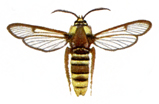
Sesiidae Stephens, 1829 (ex Aegeriidae): a world-wide family of small to medium-sized day-flying moths with glasslike hindwings and narrow forewings, numbering around 1,000 species, many of them in S America. Typically they mimic specific species of wasps, bees, hornets, flies etc.
& Ac: Sesíidae • En: clearwing moths • Fr: sésies • Ge: Sesien, Glasflügler • It: sesiidi • Ru: стеклянницы • Sp: sésidos
Shargacucullia verbasci and its caterpillar (Lampert 1907)
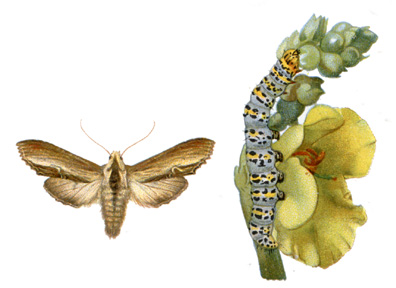
Shargacucullia (ex Cucullia) verbasci Linnaeus, 1758 [Noctuidae, Cuculliinae]: a Palearctic owlet moth with a conspicuous caterpillar: "porcelain-white and eyespotted", "… lovely, naked, shiny, gaudily spotted and streaked …, as poisonous as the mullein flowers clustering around them". Ranges through S and C Europe and N Africa. The species had been in the genus Cucullia Schrank, 1802 until in 1992 Ronkay & Ronkay placed it in their new genus Shargacucullia. All Cucullia moths are called Sharkmoths.
*Ada 55, 56
& Ac: Shargacucúllia/Cucúllia verbásci • En: Monk Moth, Mullein Moth, Shark, Sharkmoth, Cowl • Fr: le brèche, (Ada) la Cucullie • Ge: Brauner Mönch, Wollkrauteule • It: cucullia • Ru: капюшонница коровяковая
Shark, sharkmoth caterpillar: »Shargacucullia verbasci
shasta comstocki: »Aricia shasta shasta f. comstocki
Shepherd's Fritillary: »Boloria pales
Sievers' Carmelite: »Odontosia sieversi
Silvius Skipper: »Carterocephalus silvicolus
skipper: any member of the family »Hesperiidae.
In The Aurelian there is "a Chinese 'skipper' said to smell of crushed roses when alive". A great number of Lepidoptera produce scents, most often to attract mates, sometimes to repel enemies. Two which are known for their fragrance are Bhutanitis lidderdalii Atkinson, 1873 [Papilionidae] in Bhutan, Sikkim, Kashmir, Nepal and W China and Cethosia myrina C.&R. Felder, 1867 [Nymphalidae] in Indonesia – both of them no skippers. To Peter Franz I owe the suggestion that the skipper in question might be Capila pieridoides sofa Evans, 1934 [Hesperiidae, Pyrginae], a rare butterfly on the Malay Peninsula and in Indonesia of which Hartert wrote, "The scent of this beautiful insect excels every perfume known to me in loveliness, distantly resembling the well-known scent of blossoms of heliotrope". If the Chinese subspecies Capila pieridoides chinensis Evans, 1934 has a similar smell, this ought to be it.
*Stor:Aur 254; SelLet 199; Int16
Small Copper: »Lycaena phlaeas
Small Parnassius: »Parnassius phoebus
Small Pearl-bordered Fritillary: »Clossiana selene
Small Tortoiseshell: »Aglais urticae
Small White: »Pieris rapae
Smerinthus jamaicensis Drury 1773 [Sphingidae, Sphinginae]: the Twin-spotted Sphinx, a N American hawk moth from S Canada (Newfoundland to British Columbia) to Florida and Arizona. Nabokov identified a drawing Edmund Wilson had sent him as probably jamaicensis, though without the eyespots on the hindwings. *N/WLet #69=58old
Smerinthus ocellatus (Lampert 1907)

*Smerinthus ocellatus Linnaeus, 1758 [Sphingidae, Sphinginae]: For compositional more than for entomological reasons, it is likely that the three large moths mentioned in the course of Bend Sinister are the same species. The first time (p. 134) it appears in the hands of Krug's dead wife in a central scene of the novel that makes up all of Chapter 9 and strangely prefigures Ada. When she was fifteen and he eighteen, she found it in an orchard, carried it into the house (presumably her aunt's), carried it back and placed it in the lush grass at the foot of an apple tree. This is how it is described: "mouse-grey body," "short, red, blue-ocellated inferior wings," "long and marbled and deeply notched" superior wings, "shagreen caterpillar," "red hind wings basally". Its second appearance it makes on a plate in an early nineteenth-century insect book as "an ocellated hawk moth and its shagreen caterpillar" (p. 181). The third and last time is at the end of the book when the author has taken over, hears and sees a moth with furry feet clinging at the netting of his window and is going to pronounce the night good for mothing (p. 240–241).
The only moth that is in agreement with all three descriptions including the red on the hindwings is Smerinthus ocellatus, the Eyed Hawk Moth, a pretty night-flying sphingid with a wingspan of 70–80 mm, marbled curved forewings and black-blue-black eyespots on the hindwings. In can be found in all of Europe and W Asia up to an altitude of 2,000 m, from May to July, often on weeping willows, poplars and apple trees.
It should be noted that the moth Krug's wife had found in the garden in daytime and deposited there again might be the same species that visits the author at the end of the novel: "A big moth was clinging with furry feet to the netting, on the night's side; its marbled wings kept vibrating, its eyes glowed like two miniature coals. I had just time to make out its streamlined brownish-pink body and a twinned spot of colour; and then it let go and swung back into the warm damp darkness."
In a letter to Alfred Appel, Jr. (July 27, 1967) Nabokov remembers, "there is another charming moth in bend sinister (cupped in a girl's hands)."
*BendSin 133–134, 181, 240–241; NabBut 649 (L)
& Ac: Smerínthus ocellátus • En: Eyed Hawk Moth • Fr: le sphinx demi-paon • Ge: Weidenschwärmer, Abendpfauenauge • It: smerìnto ocellato • Ru: бражник глазчатый • Sp: esfinge ocelada
snowi : »Lycaena cupreus snowi
Speckled Wood: »Pararge aegeria
Speyeria Scudder, 1872, syn Semnopsyche Scudder, 1875: a genus of »Nymphalidae, subfamily Heliconiinae, tribe Argynnini (fritillaries). The genus belongs to the greater fritillaries. The type-species is »Speyeria idalia. As type-species of Semnopsyche (which turned out to be a junior synonym of Speyeria), Scudder had designated »Speyeria diana.
*NabBut 524, 717 (L)
& Ac: Speyéria
Speyeria (ex Argynnis) aglaja (not agleia) Linnaeus, 1758 [Nymphalidae]: a large fritillary of Morocco, Europe, Turkey and across Asia to China and Japan. Speyeria aglaja borealis STRAND, 1901 which Nabokov called Brenthis borealis is a subspecies from N Europe, Siberia and the Far East to Kamchatka.
*Lep1 31; LtVé 97
& Ac: Speyéria/Argýnnis aglája boreális • En: Dark Green Fritillary • Fr: le grand nacré • Ge: Großer Perlmutterfalter • Ru: перламутровка Аглая
Speyeria aphrodite Fabricius, 1787 [Nymphalidae]: the Aphrodite Fritillary (wingspan 51–73 mm), from Nova Scotia to SE British Columbia and south to Arizona, Nebraska and Georgia.
*NabBut 385 (L), 405 (L), 406 (L)
Speyeria aphrodite ethne Hemming, 1933 [Nymphalidae]: a subspecies of the Aphrodite Fritillary described from the Big Horn Mountains, Wyoming.
*NabBut 406 (L)
Speyeria atlantis, m+f (Howe 1975)
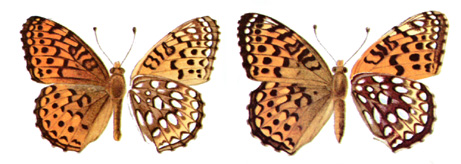
Speyeria (ex Argynnis) atlantis W.H. Edwards, 1862 [Nymphalidae]: the Atlantis Fritillary (or Mountain Silverspot), a N American fritillary which Kinbote, along with a Diana (»Speyeria diana), takes for a flower. Its range is from the Maritime Provinces to West Virginia and westward to Alaska. The wingspan is 44–67 mm.
*PaleF 169; NabBut 398 (L), 405 (L)
Speyeria atlantis atlantis W.H. Edwards, 1862 [Nymphalidae]: the nominate subspecies of the Atlantis Fritillary, described from New York State.
*NabBut 406 (L)
Speyeria atlantis canadensis dos Passos, 1935 [Nymphalidae]: a subspecies of the Atlantis Fritillary described from Newfoundland.
*NabBut 406 (L)
Speyeria atlantis electa W.H. Edwards, 1878 [Nymphalidae]: the Electa Silverspot, a subspecies of the Atlantis Fritillary described from Jefferson County, Colorado.
*NabBut 406 (L)
Speyeria atlantis hesperis W.H. Edwards, 1864 [Nymphalidae]: the Hesperis Fritillary, a subspecies of the Atlantis Fritillary described from Jefferson County, Colorado.
*StrOps 323; NabBut 406 (L)
Speyeria atlantis hollandi F. & R. Chermock, 1940 [Nymphalidae]: Holland's Fritillary, a subspecies of the Atlantis Fritillary described from Manitoba.
*NabBut 406 (L)
Speyeria atlantis lais W.H. Edwards, 1884 [Nymphalidae]: the Northwestern Silverspot, a subspecies of the Atlantis Fritillary described from Edmonton, Alberta.
*NabBut 606 (L)
Speyeria atlantis tetonia dos Passos & Grey, 1945 [Nymphalidae]: the Teton Fritillary, a subspecies of the Atlantis Fritillary described from the Tetons, Wyoming.
*Lep16
Speyeria callippe Boisduval, 1852 [Nymphalidae]: the Calippe Fritillary (wingspan 48–60 mm), in the Coast Ranges of California and on the W slopes of the Sierras up to C Oregon.
*NabBut 406 (L)
Speyeria callippe elaine dos Passos & Grey, 1945 [Nymphalidae]: Elaine's Fritillary, a subspecies of the Calippe Fritillary described from Jackson County, Oregon. Two specimens collected by Nabokov are figured in The Achievements of Vladimir Nabokov (1984), p. 247.
Speyeria callippe meadii W.H. Edwards, 1872 [Nymphalidae]: Mead's Fritillary, a subspecies of the Callippe Fritillary described from Jefferson County, Colorado.
*NabBut 406 (L); Lep16
Speyeria cybele Fabricius, 1775 [Nymphalidae]: the Great Spangled Fritillary (wingspan 54–76 mm), from S Quebec and S British Columbia to C California, New Mexico and Georgia.
*NabBut 385 (L)
Speyeria cybele carpentieri W.H. Edwards, 1876 [Nymphalidae]: Carpenter's Fritillary, in S Colorado to N New Mexico. The wingspan is c. 45 mm.
*NabBut 524
Speyeria cybele letona dos Passos & Grey, 1927 [Nymphalidae]: the Letona Fritillary, a subspecies of the Great Spangled Fritillary, in Utah.
*Lep16
Speyeria cybele novoscotia McDunnough, 1935 [Nymphalidae]: a subspecies of the Great Spangled Fritillary, in Nova Scotia.
*NabBut 406 (L)
Speyeria cybele pugetensis F. Chermock & Frechin, 1947 [Nymphalidae]: a subspecies of the Great Spangled Fritillary, described from Washington State.
*NabBut 406 (L)
Speyeria diana, m+f (Howe 1975)
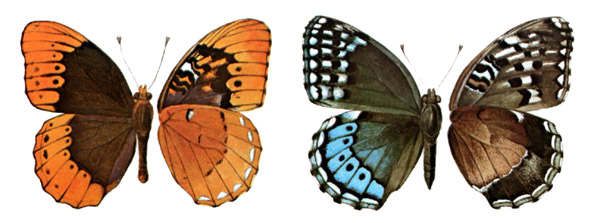
Speyeria diana Cramer, 1775 [Nymphalidae]: This probably is the large fritillary that Nabokov had in mind when in a letter to Patricia Hunt of Life (February 6, 1951) he spoke of "the only eastern butterfly that combines marvelous beauty with comparative rarity". With a wingspan of 76–98 mm, it may be the largest of all N American fritillaries. Males and females are very differently colored, the males black with a wide segmented margin of brilliant orange, the females black with a margin of wide blue spots on the hindwings and white or greenish ones on the forewings. The habitat is pine and deciduous woodlands, near rivers. Its range used to be from Maryland and Illinois south to Louisiana but due to the cutting of forests is decreasing. Robert M. Pyle says it is still common only in parts of the Great Smoky Mountains.
Diana is also the butterfly which Kinbote, in Pale Fire, takes for a flower, as he does the Atlantis Fritillary (»Speyeria atlantis).
*PaleF 169; NabBut 540; SelLet 113
& Ac: Speyéria diána • Am: Diana (Fritillary) • Ge: *Diana-Falter
Speyeria edwardsii, m+f (Howe 1975)
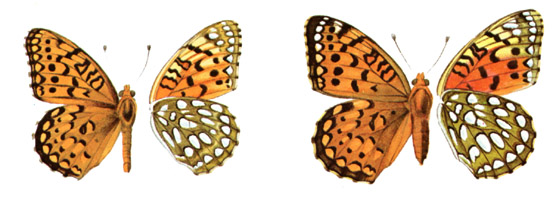
Speyeria edwardsii Reakirt, 1866 [Nymphalidae]: the Green Fritillary (or Edward's Fritillary), a large N American butterfly (wingspan 60–75 mm) flying in the foothills E of the Rocky Mountains, from Manitoba to New Mexico. The underside of the hindwings is green, with many silver spots. On November 23, 1964, at 6:45 a.m., Nabokov saw it in a dream, "the green all fused together and the brown of an extraordinary variegated hue. It eyes me in conscious agony as I try to kill it by pinching its thorax".
*N'sDreams 86; NabBut 405 (L), 406 (L), 618
Speyeria egleis Behr, 1862 [Nymphalidae]: the Egleis Fritillary, mainly in Montana, Wyoming, Idaho and Oregon. The wingspan is 38–60 mm.
*StrOps 323; NabBut 406 (L)
Speyeria egleis macdunnoughi Gunder, 1932 [Nymphalidae]: McDunnough's Fritillary, a subspecies of the Egleis Fritillary, in Montana.
*NabBut 406 (L); Lep16
Speyeria egleis oweni W.H. Edwards, 1892 [Nymphalidae]: Owen's Fritillary, a subspecies of the Egleis Fritillary described from Mt. Shasta, California.
*NabBut 406 (L)
Speyeria egleis secreta dos Passos & Grey, 1945 [Nymphalidae]: the Secret Fritillary, a subspecies of the Egleis Fritillary, in Colorado.
*StrOps 323; NabBut 524
Speyeria egleis utahensis Skinner, 1919 [Nymphalidae]: the Utah Fritillary, a subspecies of the Egleis Fritillary described from Salt Lake County, Utah.
*NabBut 406 (L)
Speyeria hydaspe purpurascens W.H. Edwards, 1877 [Nymphalidae], the Purple Fritillary, a subspecies of the Hydaspe or Lavender Fritillary (wingspan 44–60 mm), from the Yosemite Valley, California.
*StrOps 323; Lep16
Speyeria idalia (Howe 1975)
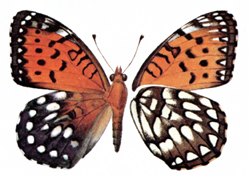
Speyeria idalia Drury, 1773 [Nymphalidae]: the Regal Fritillary, a large fritillary, from S New England westward to North Dakota and southward to Virginia, Oklahoma and Colorado. The forewings (wingspan 66–92 mm) are a bright orange with blue-black spots and a white-dotted margin, the hindwings are black with light spots. It is a native of the prairie and became rarer when the prairies dwindled.
*NabBut 405 (L)
Speyeria mormonia Boisduval, 1869 [Nymphalidae]: the Mormon Fritillary (wingspan 41–51 mm), on alpine and subalpine meadows from S Alaska southwest to S Dakota and south to Utah, Arizona and New Mexico.
*NabBut 406 (L)
Speyeria mormonia bischoffii W.H. Edwards, 1870 [Nymphalidae]: Bischoff's Fritillary, the Alaskan population of the Mormon Fritillary (»Speyeria mormonia).
*NabBut 295
Speyeria mormonia eurynome W.H. Edwards, 1872, syn mormonia clio W.H. Edwards, 1874 [Nymphalidae]: the Eurynome Fritillary, a subspecies of the Mormon Fritillary described from Park County, Colorado.
*NabBut 406 (L), 409 (L); Lep16
Speyeria nokomis nitocris W.H. Edwards, 1874 [Nymphalidae]: the Nitocris Fritillary, described from Arizona, a subspecies of the Nokomis Fritillary (Speyeria nokomis W.H. Edwards, 1862).
*NabBut 406 (L)
Speyeria secreta: »Speyeria egleis secreta
Speyeria zerene Boisduval, 1852 [Nymphalidae]: the Zerene Fritillary (wingspan 48–64 mm), from SE Alaska and British Columbia east to Saskatchewan and South Dakota and south to C California, N Arizona and C New Mexico.
*NabBut 406 (L)
Speyeria zerene garretti Gunder, 1932 [Nymphalidae]: Garrett's Fritillary, a subspecies of the Zerene Fritillary, in British Columbia.
*Lep16
Speyeria zerene platina Skinner, 1897 [Nymphalidae]: Skinner's Fritillary, a subspecies of the Zerene Fritillary described from Weber County, Utah.
*NabBut 406 (L)
Speyeria zerene sinope dos Passos & Grey, 1945 [Nymphalidae]: a subspecies of the Zerene Fritillary described from Rocky Mountains National Park, Colorado.
*NabBut 406 (L)
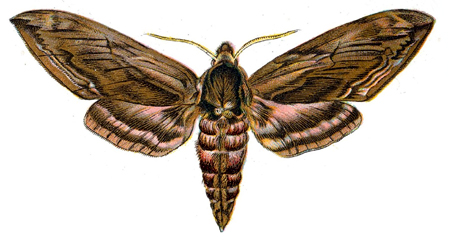
Sphingidae Latreille, 1802: a family of small to large moths, comprising around 1,000 species, most of them in the tropics. Their bodies are strong, and they have excellent flying capabilities, some of them reaching 50 kmh. They have big eyes and long trunks, allowing them to suck nectar from flowers as they hover over them, hummingbird fashion. Many of them fly at dusk. The type-species is Sphinx ligustri LINNAEUS, 1758, the Privet Hawk Moth.
*NabBut 205 (FB), 268 (L); LtVé 466
& Ac: Sphíngidae • En: sphingids, hawks, hawk moths, sphinx moths • Fr: sphingidés, sphinx • Ge: Sphingiden, Schwärmer • It: sfìngidi • Ru: бражники, (DarII) свингиды • Sp: esfíngidos
Sphingonaepiopsis (ex Pterogon) gorgoniades Hübner, 1819 [Sphingidae, Macroglossinae]: a hawk moth in SW Europe, S Russia, Crimea, Turkey, Turkmenistan, Afghanistan.
*Lep1 33
Sphinx convolvuli: »Agrius convolvuli
Sphinx ligustri Linnaeus, 1758 [Sphingidae, Sphinginae, tribe Sphingini]: a Palearctic hawk moth , flying at dusk in all of Eurasia and Japan up to 62°N. The wingspan is 80–110 mm. The forewings are dark brown, the hindwings are a dusky pink with dark brown bands, the body is deep pink with black bands.
*Possibly Ada 250
& Ac: Sphinx ligústri • En: Privet Hawk Moth • Fr: le sphinx du troène • Ge: Ligusterschwärmer • It: sfinge del ligustro • Ru: бражник бирючинный, сиреневый бражник • Sp: esfinge del aligustre
Sphinx odetta: the Cattleya Hawk Moth or Odettian Sphinx, an invented »hawk moth in Ada, like many hawk moths undoubtedly called after its foodplant which seems to be the tropical American orchid Cattleya, Odette's elegant favorite flower in Proust's Un Amour de Swann. ("To play Cattleya" becomes a private synonym for Swann's and Odette's lovemaking.) These are the "mauve shades of Monsieur Proust". In his copy of Ada, Nabokov glossed 'Cattleya Hawk Moth ' and 'Odettian Sphinx' as Sphinx odetta (Boyd, personal communication). Hence this is the scientific name he intended for this imaginary moth. (In the French version of Ada revised by Nabokov, it is 'le Sphinx d'Odette' and 'le Sphinx du Catleya'. They are one and the same insect, of course.)
Nabokov in his lecture on Proust (p. 241): "This rose-purple mauve, a pinkish lilac, a violet flush, is linked in European literature with certain sophistications of the artistic temperament. It is the color of an orchid, Cattleya labiata (the genus called thus after William Cattley, a solemn British botanist), an orchid, which today, in this country, regularly adorns the bosoms of matrons at club festivities. This orchid in the nineties of the last century in Paris was a very rare and expensive flower. It adorns Swann's lovemaking in a famous but not very convincing scene" (Lectures on Literature, p. 241).
The Cattleya Hawk Moth seems to be an insect that exaggerates. According to the description given of its caterpillar ("a seven-inch-long colossus, flesh colored, with turquoise arabesques") and its pupa ("an elephantoid mummy with a comically encased trunk of the guermantoid type"), the larva somewhat resembles that of »Agrius convolvuli LINNAEUS, 1758 which is large, though not seven inches long, but only up to four and a half, and lacks turquoise arabesques, but whose large pupa has an unusually long trunk. Larger still (up to 150 mm, or 6 inches) and equipped with colorful markings is the caterpillar of »Acherontia atropos, the Death's Head Moth. The "guermantoid" trunk refers to the long nose predominant in the Guermantes family ever since Geneviève de Brabant.
*Ada 56
& Fr: (Ada) le Sphinx Cattleya, le Sphinx d'Odette • Ge: *Cattleyaschwärmer, *Odettaschwärmer • It: sfinge del cattleya
& Ac: Hérse convólvuli: En: Convolvulus Hawk Moth , Unicorn • Fr: le sphinx du liseron • Ge: Windenschwärmer • It: sfinge del convolvolo • Ru: бражник вьюнковый • Sp: esfinge de la correhuela
Sphinx sylvia: "the Sylvia Sphinx," an imaginary hawk moth Nabokov drew in 1951 for his Wellesley College colleague, the short-story writer Sylvia Berkman, in a copy of Conclusive Evidence.
*NabBut plate 16
sphyngid: another spelling for the members of the family »Sphingidae, hawk moths.
*N/WLet #69=58old
Spialia (ex Pyrgus) orbifer Hübner, 1823 [Hesperiidae, Pyrginae]: the Orbed Red-underwing Skipper, described from Hungary, in Sicily, E Europe, Balkans, Turkey, Middle East, S Russia, S Urals, Afghanistan, Tianshan.
*Lep1 29
Spudaea (ex Orthosia) ruticilla Esper, 1791 [Noctuidae, Acronictinae]: an owlet moth of C, SW and SE Europe. Nabokov in the paper about his collecting trip to the Pyrenees in 1929: "Orthosia ruticella, ranging from reddish to leaden grey, and other spring moths began coming to light in the last days of February."
*Lep2 256
Staurophora celsia (Hübner 1793-1827)
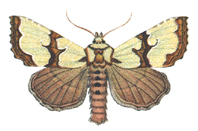
Staurophora celsia Linnaeus, 1758 [Noctuidae, Noctuinae]: On September 28, 1925, Nabokov wrote his mother in Prague that on a Berlin linden tree he had found "a wonderfully rare moth – the dream of German collectors (it's rather large, with soft-emerald forewings marked with brown)" and that he had taken it to the owner of a butterfly shop on Motzstrasse who offered to spread it. What moth was it? Kurt Johnson (1999, p. 121) ventures the guess that it was "the large and splendid Moon moth, a European relative of the North America's luminescent green Luna moth". In this case it would have to be »Graellsia isabellae Graëlls 1849 [Saturniidae], the Spanish Moon Moth, whose wings, however, are a transparent blue-green and not soft-emerald and which is restricted to the mountainous regions of C and N Spain and would not err as far as Berlin.
Robert Michael Pyle and I independently identified the Berlin moth as Staurophora celsia (Nabokov's Butterflies, p. 723). Its range is C and N Europe, Russia and Siberia. It is rare to very rare except in isolated spots where it may be abundant. Its preferred habitat is sandy soil at the rim of coniferous forests. Around Berlin, it was relatively frequent. Also, it flies at just the right time, in September. The wingspan is 37–42 mm.
& Ac: Stauróphora célsia • Ge: Malachiteule • Ru: пламенница благородная
|
Stauropus fagi (Hofmann 1894) |
Caterpillar of the Lobster Moth (Sepp 1762) |
|
|
|
Stauropus fagi Linnaeus, 1758 [Notodontidae]: a prominent moth with a wingspan of 45–60 mm at home in the warmer parts of Europe and Asia. The caterpillars feed on oak, beech and lime and if occurring in masses may be a pest. About the mimetic tricks of the caterpillar Nabokov wrote: "… in infancy [it] looks like bird's dung, but after molting [it] develops scrabbly hymenopteroid appendages and baroque characteristics, allowing the extraordinary fellow to play two parts at once (like the actor in Oriental shows who becomes a pair of intertwisted wrestlers): that of a writhing larva and that of a big ant seemingly harrowing it."
*SpeakM 124
& Ac: Staurópus fági • En: Lobster Moth, Lobster Prominent • Fr: l'écureuil, le bombyx du hêtre, l'harpye des hêtres • Ge: Buchenspinner • Ru: вилохвост буковый • Sp: guerrero del haya
Strymon edwardsii: »Satyrium edwardsii
Strymon itys: »Satyrium sylvinus itys
'Strymon' melinus Hübner, 1818 [Lycaenidae, Theclinae]: the Gray or Common Hairstreak, in S Canada from Nova Scotia to British Columbia and southward through the United States and C America to Venezuela.
*StrOps 327
Strymon saepium: »Satyrium saepium
Strymon titus: »Harkenclenus titus
Strymonidia w-album: »Satyrium w-album
sulphur: the common name for a subfamily of »Pieridae, subfamily Coliadinae. They usually are more or less yellow.
*NabBut 540
The "rose-margined sulphur" is the Pink Edged Sulphur, »Colias interior.
*SpeakM 138
swallowtail: a great number of species of the genera Papilio Linnaeus, 1758, Iphiclides Hübner, 1819 and Graphium Scopoli, 1777 [Papilionidae]. Usually they are large, splendidly patterned and colored and with a tail on each hindwing. The great majority of swallowtails are tropical butterflies. The tails serve a purpose. When the butterfly is resting, they look as if they were its antennae, so an interested bird will pick at the wrong end, giving the butterfly a chance to escape.
*Stor:Xmas 134; Stor:TerraInc 295; LolScrpl 176; SelLet 287
The zebra-striped swallowtail gliding past in Glory, its tails extended and joined, must be »Iphiclides podalirius, the Scarce Swallowtail of Europe.
*Glory 9
In "Father's Butterflies", Fyodor marvels at the images in his father's work on the Russian butterfly fauna and especially at "the splendid blue cast" of some Far Eastern "black 'Cavalier,' with a tiger in the background to lend a tropical flavor to the Far Eastern fauna". There are several large and beautiful Asiatic swallowtails that are black with blue scaling; in some, even the bodies are black.
There is a problem, however. Godunov Senior's monumental work is entitled Butterflies and Moths of the Russian Empire, and it may be supposed that the background flora and fauna in the figures of an ambitious work like his is not haphazardly ornamental and that the tiger is typical of that particular swallowtail's habitat. The only tigers on Russian territory were Siberian tigers of which a few specimens have managed to survive in the Amur and Ussuri regions to this day. If Godunov Senior's explicitly patriotic work has strictly limited itself to Russian Lepidoptera, there is little choice left. The butterfly might be Sinoprinceps xuthus LINNAEUS, 1767, a machaon-like insect whose males are all black and pale yellow, with just a hint of blue and red ocellae, flying in the Ussuri region.
*NabBut 206 (FB)
& En: swallowtail, cavalier • Fr: chevalier, (Don) le porte-queue • Ge: Schwanzfalter, Schwalbenschwänze • It: macaoni • Ru: (DarII) кавалер • Sp: macaón
Swallowtail, Old World Swallowtail: »Papilio machaon
Syngea Hübner, 1819: an abandoned genus of »Nymphalidae, subfamily Satyrinae, tribe Erebiini (US alpines, GB arguses and graylings). The type-species was »Erebia pronoe.
*NabBut 591 (BE)
Syrichtus Boisduval, 1834: a valid genus of »Hesperiidae (skippers), subfamily Pyrginae (pyrgine skippers). The type-species is »Syrichtus proto, the Sage Skipper. Originally, the genus was erected for all of the European black-and-white skippers. Subsequently, many of its members were split off into the genus Pyrgus.
*NabBut 209 (FB), 230 (FB)
Syrichtus (ex Muschampia, Pyrgus) proto Ochsenheimer, 1808 [Hesperiidae]: the Sage Skipper or Large Grizzled Skipper, in Africa, Iberian Peninsiula, S Europe, Turkey, described from Portugal.
*Lep1 29
